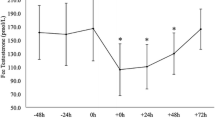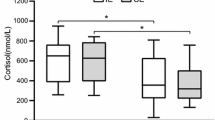Abstract
This study examined the acute hormonal responses to a single high power resistance exercise training session. Four weight trained men (X ± SD; age [yrs] = 24.5 ± 2.9; hgt [m] = 1.82 ± 0.05; BW [kg] = 96.9 ± 10.6; 1 RM barbell squat [kg] = 129.3 ± 17.4) participated as subjects in two randomly ordered sessions. During the lifting session, serum samples were collected pre- and 5 min post-exercise, and later analyzed for testosterone (Tes), cortisol (Cort), their ratio (Tes/Cort), and lactate (HLa). The lifting protocol was 10 × 5 speed squats at 70% of system mass (1 RM + BW) with 2 min inter-set rest intervals. Mean power and velocity were determined for each repetition using an external dynamometer. On the control day, the procedures and times (1600–1900 h) were identical except the subjects did not lift. Tes and Cort were analyzed via EIA. Mean ± SD power and velocity was 1377.1 ± 9.6 W and 0.79 ± 0.01 m s−1 respectively for all repetitions, and did not decrease over the 10 sets (p < 0.05). Although not significant, post-exercise Tes exhibited a very large effect size (nmol L−1; pre = 12.5 ± 2.9, post = 20.0 ± 3.9; Cohen’s D = 1.27). No changes were observed for either Cort or the Tes/Cort ratio. HLa significantly increased post-exercise (mmol L−1; pre = 1.00 ± 0.09, post = 4.85 ± 1.10). The exercise protocol resulted in no significant changes in Tes, Cort or the Tes/Cort ratio, although the Cohen’s D value indicates a very large effect size for the Tes response. The acute increase for Tes is in agreement with previous reports that high power activities can elicit a Tes response. High power resistance exercise protocols such as the one used in the present study produce acute increases of Tes. These results indicate that high power resistance exercise can contribute to an anabolic hormonal response with this type of training, and may partially explain the muscle hypertrophy observed in athletes who routinely employ high power resistance exercise.
Similar content being viewed by others
References
Bosco, C., Colli, R., Bonomi, R., et al., Monitoring Strength Training: Neuromuscular and Hormonal Profile, Med. Sci. Sports Exerc., 2000, vol. 32, no. 1, p. 202.
Adlercreutz, H., Harkonen, M., Kuoppasalmi, K., et al., Effect of Training on Plasma Anabolic and Catabolic Steroid Hormones and Their Response during Physical Exercise, Int. J. Sports Med., 1986, vol. 7, p. S27.
Fry, A.C., Overload and Regeneration during Resistance Exercise, in Overload, Performance Incompetence, and Regeneration in Sport, Lehmann, M., Foster, C., Gastmann, U., et al., Eds., New York: Kluwer Academic/Plenum, 1999, p. 149.
Fry, A.C. and Kraemer, W.J., Resistance Exercise Overtraining and Overreaching: Neuroendocrine Response, Sports Med., 1997, vol. 23, no. 2, p. 106.
Gotshalk, L.A., Loebel, C.C., Nindl, B.C., et al., Hormonal Responses of Multi-Set Versus Single-Set Heavy-Resistance Exercise Protocols, Can. J. Appl. Physiol., 1997, vol. 22, no. 3, p. 244.
Kraemer, W.J., Fry, A.C., Warren, B.J., et al., Acute Hormonal Responses in Elite Junior Weightlifters, Int. J. Sports Med., 1992, vol. 13, no. 2, p. 103.
Kraemer, W.J., Marchitelli, L., Gordon, S.E., et al., Hormonal and Growth-Factor Responses to Heavy Resistance Exercise Protocols, J. Appl. Physiol., 1990, vol. 69, no. 4, p. 1442.
Kraemer, W.J., Staron, R.S., Hagerman, F.C., et al., The effects of Short-Term Resistance Training on Endocrine Function in Men and Women, Eur. J. Appl. Physiol., 1998, vol. 78, no. 1, p. 69.
Fahey, T.D., Rolph, R., Moungmee, P., et al., Serum Testosterone, Body Composition, and Strength of Young Adults, Med. Sci. Sports, 1976, vol. 8, p. 31.
Hakkinen, K., Pakarinen, A., Newton, R.U., and Kraemer, W.J., Acute Hormone Responses to Heavy Resistance Lower and Upper Extremity Exercise in Young Versus Old Men, Eur. J. Appl. Physiol., 1998, vol. 77, no. 4, p. 312.
Kraemer, W.J., Gordon, S.E., Fleck, S.J., et al., Endogenous Anabolic Hormonal and Growth-Factor Responses to Heavy Resistance Exercise in Males and Females, Int. J. Sports Med., 1991, vol. 12, no. 2, p. 228.
Volek, J.S., Kraemer, W.J., Bush, J.A., et al., Testosterone and Cortisol in Relationship to Dietary Nutrients and Resistance Exercise, J. Appl Physiol., 1997, vol. 82, no. 1, p. 49.
Weiss, L.W., Cureton, K.J., and Thompson, F.N., Comparison of Serum Testosterone and Androstenedione Responses to Weight Lifting in Men and Women, Eur. J. Appl. Physiol., 1983, vol. 50, no. 3, p. 413.
Ratamass, N.A., Kraemer, W.J., Volek, J.S., et al., Effects of Heavy Resistance Exercise Volume on Post-Exercise Androgen Receptor Content in Resistance-Trained Men, Med. Sci. Sports Exerc., 2004, vol. 36, no. 5, p. S238.
Ahtlainen, J.P., Pakarinen, A., Kraemer, W.J., and Hakkinen, K., Acute Hormonal and Neuromuscular Responses and Recovery to Forced vs. Maximum Repetitions Multiple Resistance Exercises, Int. J. Sports Med., 2003, vol. 24, no. 6, p. 410.
Linnamo, V., Pakarinen, A., Komi, P.V., et al. Acute Hormonal Responses to Submaximal and Maximal Heavy Resistance and Explosive Exercises in Men and Women, J. Strength Cond. Res., 2005, V. 19, no. 3, p. 566.
Fry, A.C., Kraemer, W.J., and Ramsey, L.T., Pituitary-Adrenal-Gonadal Responses to High Intensity Resistance Exercise Overtraining, J. Appl. Physiol., 1998, vol. 85, no. 6, p. 2352.
Fry, A.C., Kraemer, W.J., Stone, M.H., et al., Exercise-Induced Endocrine Responses to Over-Reaching before and after One Year of Weightlifting Training, Can. J. Appl. Physiol., 1994, vol. 14, no. 4, p. 400.
Guezennec, Y., Leger, L, Lhoste, F., et al., Hormone and Metabolite Response to Weight-Lifting Training Sessions, Int. J. Sports Med., 1986, vol. 7, p. 100.
Hakkinen, K., Pakarinen, A., Alen, M., et al., Relationships between Training Volume, Physical Performance Capacity, and Serum Hormone Concentrations during Prolonged Training in Elite Weight Lifters, Int. J. Sports Med., 1987, vol. 8(Suppl.), p. 61.
Harber, M.P., Fry, A.C., Rubin, M.R., et al., Skeletal Muscle and Hormonal Adaptations to Circuit Weight Training, Scand. J. Med. Sci. Sports, 2003, vol. 13, p. 1.
Kraemer, W.J., Volek, J.S., Bush, J.A., et al., Hormonal Responses to Consecutive Days of Heavy-Resistance Exercise with or without Nutritional Supplementation, J. Appl. Physiol., 1998, vol. 85, no. 4, p. 1544.
McCall, G.E., Byrnes, W.C., Fleck, S.J., et al., Acute and Chronic Hormonal Responses to Resistance Training Designed to Promote Muscle Hypertrophy, Can. J. Appl. Physiol, 1999, vol. 24, no. 1, p. 96.
Kraemer, W.J., Kilgore, J.L., Kraemer, G.R., and Castracane, V.D., Growth-Hormone, IGF-1, and Testosterone Responses to Resistive Exercise, Med. Sci. Sports Exerc., 1992, vol. 24, no. 12, p. 1346.
Volek, J.S., Boetes, M., Bush, J.A., et al., Response of Testosterone and Cortisol Concentrations to High-Intensity Resistance Exercise Following Creatine Supplementation, J. Strength Cond. Res., 1997, vol. 11, no. 3, p. 182.
Fry, A.C. and Hoffman, J.R., Training Responses and Adaptations of the Endocrine System, in Conditioning for Strength and Human Performance, Chandler, T.J. and Brown, L.E., Eds., Philadelphia, Lippincott: Williams and Wilkins, 2008, p. 94.
Fry, A.C., Kraemer, J.W., Stone, M.H., et al., Endocrine and Performance Responses to High Volume Training and Amino Acid Supplementation in Elite Junior Weightlifters, Int. Sports Nutri., 1993, vol. 3, p. 306.
Hakkinen, K., Neuromuscular and Hormonal Adaptations during Strength and Power Training, J. Sports Med. Phys. Fit., 1989, vol. 29, p. 9.
Hakkinen, K., Pakarinen, A., Alen, M., and Komi, P.V., Daily Hormonal and Neuromuscular Responses to Intensive Strength Training in One Week, Int. J. Sports Med., 1988, vol. 9, no. 6, p. 422.
Raastad, T., Bjoro, T., and Hallen, J., Hormonal Responses to High- and Moderate-Intensity Strength Exercise, Eur. J. Appl. Physiol., 2000, vol. 82, nos. 1–2, p. 121.
Kraemer, W.J. and Fry, A.C., Strength Testing: Development and Evaluation of Methodology, in Physiological Assessment of Human Fitness, Maud, P.J. and Foster, C., Eds., Champaign, IL: Human Kinetics, 1992, p. 115.
Dill, D.B. and Costill, D.L., Calculation of Percentage Changes in Volume of Blood, Plasma and Red Cells in Dehydration, J. Appl. Physiol., 1974, vol. 37, p. 247.
Author information
Authors and Affiliations
Corresponding author
Rights and permissions
About this article
Cite this article
Fry, A.C., Lohnes, C.A. Acute testosterone and cortisol responses to high power resistance exercise. Hum Physiol 36, 457–461 (2010). https://doi.org/10.1134/S0362119710040110
Received:
Published:
Issue Date:
DOI: https://doi.org/10.1134/S0362119710040110




